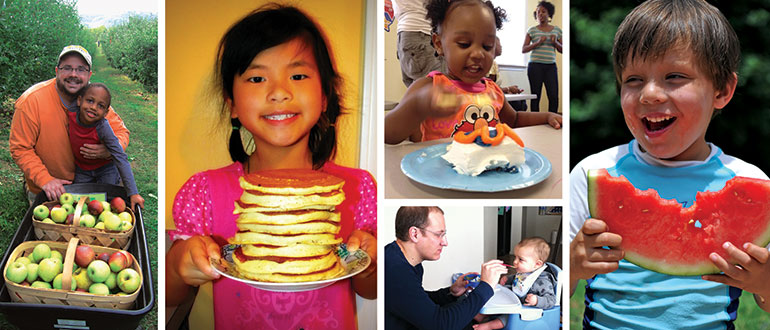“Knowing deep within us that someone is going to feed us when we are hungry is how trust and love begin.”
–Mister Rogers
The attachment cycle is fulfilled by meeting a child’s physical and emotional needs—feeling hunger, needing attention, being wet or cold—over and over again. Feeding is one of the most reliable and obvious opportunities to help a child feel safe and cared for, and to build trust, whether you have brought home an infant or an older child.
Amy recalls an episode involving her teen-aged foster son, who had a habit of running away. Soon after he was placed with the family, he disappeared for 36 hours. When he returned, “We made sure he was OK, then threw a box of mac-n-cheese on the stove to get him some comfort food. That floored him, because he’d been denied food in his home after his running away. I think this gesture bonded him to us more than anything else could have.”
When feeding is not going well, however, not only is the opportunity for bonding lost, but the troubled feeding relationship becomes a source of conflict that can raise barriers to trust and attachment.
“We worked hard to have our daughter with us, so I hated to admit that I wasn’t enjoying her, and that our other kids were really suffering. Our lives revolved around what she was or wasn’t putting in her mouth,” says Kelly, the mother of a three-year-old adopted from China. After seeking help, Kelly now feels they are moving in the right direction: “Our stress at mealtimes is way down, she’s happier at the table, and we can see her eating starting to improve. I am beginning to enjoy my family again, and it feels great.”
What worked for Kelly’s family and many others, including my own, was the Trust Model of feeding, developed by dietitian and therapist Ellyn Satter. If we restore or establish structured, reliable, rewarding, and healthy eating strategies for the whole family, we allow children to rely on the messages of hunger and fullness that come from inside their bodies, which helps them grow up to be competent eaters. Perhaps most important, when we feed our children reliably and with love, we teach them they can rely on us as parents. How can you bring the Trust Model to your dinner table?
A Healthy Feeding Model
You may not know your child’s history, and you can’t change it if you do, but you will be better off if you follow his cues, consider things from his perspective, and take the lead as the parent. Satter developed the Division of Responsibility (DOR) in feeding, which is the principle underlying the Trust Model. The DOR says:
- Parents decide three things: the when, the where, and the what of feeding. (Infants do best fed on demand, so they decide the when. This responsibility shifts to the parent in late infancy/early toddlerhood.)
- Children decide whether and how much they will eat from what is provided.
The DOR is based on permission, nurturing, and providing. It rejects the idea that children should diet or worry about weight, and does not focus on avoidance or “shouldn’ts.”
It sounds simple, but it is not easy. Feeding well is hard work that you will do for years, but struggling with feeding is even harder. Most parents and children who struggle around food issues mix up their jobs. That is, the parents let the child do their job of selecting foods and deciding when and where to eat. Likewise, parents should not try to do the child’s job of deciding how much to eat by limiting food intake or by pressuring the child to take “just two more bites.”
Step 1: When to Feed, or Structure
Reliable structure is an important way to help children with eating. Structure allows children to heed their internal cues of hunger and fullness and not to worry about eating between the scheduled meals and snacks. Generally,
- Younger children eat every two or three hours, roughly, three meals and two to three snacks a day.
- Older children eat every three to four hours, at about the same times every day. This adds up to three meals and one or two snacks a day.
- If a child is new to your family, or has significant nutritional or growth delays, you may need to offer food more often at first, until you learn to read your child’s cues and he learns to trust that he will be taken care of.
Many foster and institutionalized children have extreme anxiety about food. They may have come from chaotic and unsupportive homes, and food may have been limited. Being absolutely reliable about structure is critical. Don’t skip a snack because you are going to the park. Deborah Gray says, in Attaching in Adoption, “Successful parents have seen how much better their child performs with high structure. They work hard to provide that structure.”
Structure takes a lot of pressure off feeding. If a child eats a small meal or snack–which he will, since the amounts and types of food that a young child eats can vary greatly by day or week–he will soon have another opportunity to eat, so the parents can relax. Structure can be flexible enough to let the family eat together every night. Plan for a balanced and filling snack after school on days when dinnertime will be later. On days when an early dinner works better, plan on serving a snack before bed.
Step 2: Where to Feed (and with Whom)
Family meals are important. All of you have to eat, and it’s better to do it together. Ideally, all meals would find the whole family around a table. However, one supportive adult eating with the child makes it a family meal. Children do best when they sit down to eat and are free from TV, phones, and toys. Meals and snacks can be fun and pleasant times to connect.
Eating with the family:
- Helps kids tune in to “hungry” and “full” cues.
- Helps kids eat the right amount.
- Lowers the risk of choking.
- Helps children learn to like new foods. Seeing someone they trust enjoy a food is the best first step.
- Aids attachment and helps children feel they are part of the family.
- Is the best predictor of overall success in life, more than socioeconomic or educational milieu or after-school activities, several studies have found.
Food should be eaten with parents and should come from parents. Ivan, age 14, was adopted from Romania, with his younger sister. Marina was attached to Ivan as her caregiver. When the siblings came to live with their new family, their mother was deliberate about feeding both children. Showing that food came from Mom and Dad allowed Ivan to be nurtured and to attach, and it was critical in allowing Marina to transfer her attachment to her parents. Both needed to be cared for and nurtured, setting them free to be children.
Kim, who adopted three- and six-year-old sisters, says, “Preparing and giving both girls food helped them see that they need me.” She did not make food available to the girls at all times. She felt it was critical to demonstrate that food came from her and that she would meet their needs. She offered and maintained eye contact during meals and snacks.
Step 3: What to Feed
I put this last, but most folks who work with kids and food start here. There are countless articles and books about how to disguise veggies or sneak in more protein. But without steps one and two in place (the “how” of feeding, or the “feeding relationship”), step three is even more of a struggle. The key to improving what kids eat boils down to how they are being fed. Let the child count on enjoyable, no-pressure family meals that include a variety of tasty foods.
Parents have heard about the USDA Food Pyramid for years–and MyPlate more recently–but trying to follow too many prescriptive rules brings pressure into forming a healthy feeding relationship. Young children tend to eat erratically, consuming a lot at lunch and almost nothing at snacktime, or vice versa, and most often picking one or two foods from what is available. Kids who are offered a variety of foods without pressure tend to consume a balanced diet over several days.
At meals, try to offer:
- One or two grains, one being bread or cultural equivalent (carbohydrate)
- Two fruits/veggies (carbohydrate and fiber)
- One dairy or dairy substitute (protein, fat, and carbohydrate)
- One meat or bean or nut (protein and fat)
Offering fat, protein, and carbohydrates–at meals and snacks–is essential for stable blood sugar levels and energy. I see too many parents offer their child a snack of Goldfish crackers and juice or peeled apple slices and juice. Such snacks are generally followed, 30 to 60 minutes later, with a meltdown or whining for more food. Carbohydrates offer quick energy and are certainly necessary and favored (particularly by small, growing children), but protein and fat (and fiber) are also needed to help the child feel full and to give him the extended energy to make it to the next meal or snack.
Notice that I did not say, “Get the child to eat fat, protein, and carbohydrates”; I say rather, offer them.
While it’s work to put all these options on the table, it can save time and aggravation. A parent’s food prep job is done when the food is on the table. There should be no separate meals for kids and no need to argue or negotiate over food.
Addressing Food Insecurity
When children are not fed reliably, do not get enough food, or have to compete for enough, they develop food anxiety. If a child hasn’t been able to count on being fed, he will have trouble trusting or understanding that it is coming again.
“Marcus liked to hold and play with teething biscuits. He would chew on one a little, then lose interest, but keep it clutched in his hands for hours. If we tried to take it from him, he became very angry,” said Sue, soon after adopting her 18-month-old son.
Many resources on adoption and hoarding advise allowing the child to have snacks in his backpack or carry food in a pocket, or even to keep Tupperware containers of food in his bedroom at night. Consider Marcus, who did not want to let go of his biscuit. He might be allowed to hang on to it for a while, and maybe even to keep one in a baggie in his pocket. Follow his lead. If he throws a tantrum about having his biscuit taken away, allow him to carry it. But the parent must also be absolutely reliable about regularly providing food. You may need to offer food frequently during the initial post-adoption period, perhaps every hour or so.
My main concern with the general recommendation of allowing kids with a history of food insecurity to have their own food stash is that it may make parents feel they are off the hook for providing regular meals and snacks. Also, the child allowed to get food whenever he wants may still feel responsible for feeding himself. It is a missed opportunity to deepen the attachment with your child. Feeding your child directly shows her that you will take care of her. It builds trust. Completing the cycle of need and having her need met, over and over again, is the basis for attachment.
One foster mom had a little boy she couldn’t keep out of the fridge. On occasion, he would eat to the point of making himself sick. The mom didn’t want to lock the fridge, feeling that restricting his food access was the wrong strategy. Instead, she assigned one of the refrigerator drawers to him. She stocked it with food that he liked, and told him that the drawer would always be full. While he could not take food at random, this drawer was his. He checked the drawer often, with Mom’s reassurance that this was his food, and he could choose from it for meals and snack times. She stuck to a consistent schedule of meals and snacks, and made certain that the drawer was never empty. Gradually, he forgot about the drawer.
Another boy, adopted as a preschooler, loved cereal. He would frantically gobble as much as he could, and cry if he was limited. His parents realized that, when he saw an empty cereal box, he thought there would be no more cereal, ever. Overstocking the pantry with his favorite cereals reassured him. At breakfast, he was allowed to eat as much as he wanted. During the day, frequent trips to the pantry with a parent assured him that he would get enough. Pretty soon, he was eating about the same amount as his brother and was no longer anxious at meals.
While you can allow access to food, or let your child clutch a biscuit for hours, don’t use constant access to food as an “easy out” from the task of reliable feeding. The way to lessen hoarding behaviors is to lessen anxiety about food. The best way to lessen anxiety about food is to be reliable about feeding–and not to limit what your child eats. Your child may need reassurances, such as “There will always be enough food.” Show him the well-stocked pantry and say, “See, there is always enough food here.”
Your First Meals Together
You may have months to prepare for the arrival of your child, or, in the case of foster care, hours. If you are able to find out what foods your child is used to eating, having these on hand may help with the transition. However, you may not know your child’s history with food. Assume that it has been less than ideal, and be absolutely reliable about providing food. Your child won’t know she can trust you yet, so showing her, with feeding and everything else, will help her feel safe and begin the process of attachment.
You may want to offer a meal or snack every few hours during the transition period, even for an older child. For a younger child, offer food in different forms, especially if you don’t know her skills with eating. Have a bottle with a few nipple options, a sippy and a straw cup, some soft foods, and some finger-food options. Your child will let you know what she is ready for and what she likes to eat. Sit with your child and reassure her she can eat as much, or as little, as she wants.
When eight-month-old Adina was adopted from Ethiopia, her weight-for-length was close to the 80th percentile. Her mother, Rebecca, was told that her daughter had been “overfed” in the orphanage and was advised to limit formula. Even though Adina screamed after every feeding and clearly seemed interested in eating more, her mother thought she should stick to the limits her pediatrician had advised. Adina’s trust in her new mother was undermined from the start.
Adina is now two years old, and the family is changing to the Trust Model. Rebecca says, “I did what the doctor told us to do. Now I wonder: If I had given her a few ounces more here and there, and let her decide when she was done, maybe she wouldn’t have developed such a serious food obsession.”
You may have heard the phrase “food is love,” but when you think about it, feeding is love. Food is sustenance, feeding is nurturing. A scrambled egg on a plate is delicious and fulfills nutritional needs. But scrambled eggs shared over a smile and a chat about weekend plans brings you together. Food is food and feeding is love. Add a pinch or a generous handful of love to every meal.
This piece was adapted from “Love Me, Feed Me: The Adoptive Parent’s Guide to Ending the Worry About Weight, Picky Eating, Power Struggles, and More” with permission.



